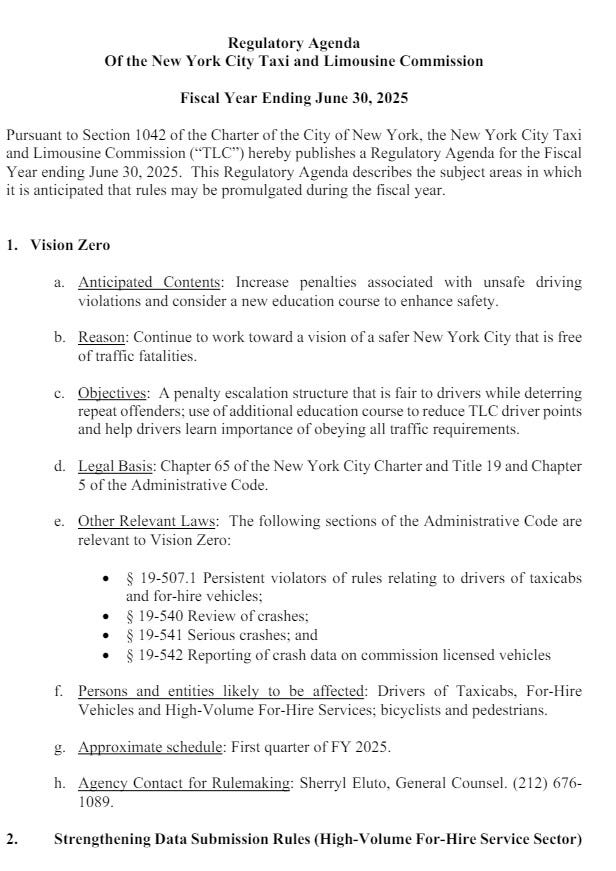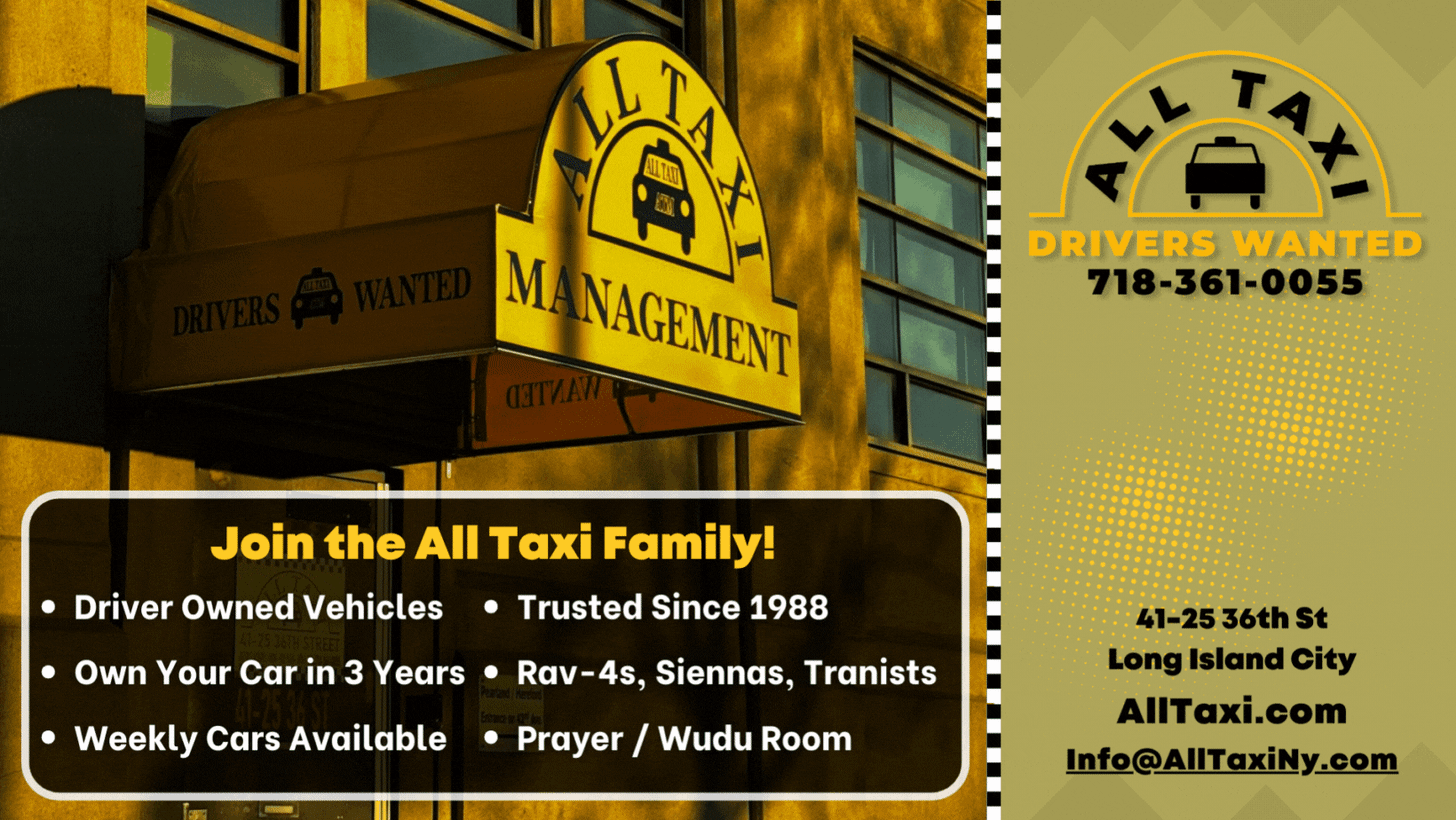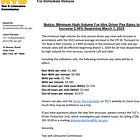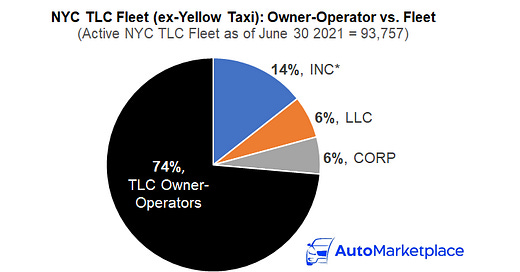

Discover more from AutoMarketplace
🚕🥅 NYC TLC Publishes July 2024 to June 2025 Regulatory Agenda
NYC Taxi & Limousine Commission (NYC TLC) publishes Fiscal Year 2025 (July 2024 to June 2025) Regulatory Agenda. Agenda describes subject areas that TLC will target for new policymaking
NYC TLC publishes its Fiscal Year 2025 Regulatory Agenda, covering the 12 month period from July 1, 2024 to June 30, 2025
Regulatory Agenda gives important insight into future TLC policy initiatives
We summarize the TLC’s Regulatory Agenda and share some thoughts
Firstly, we want to thank AutoMarketplace friend and NYC Taxi News podcast regular Carolyn Protz (X handle NYC_TMODA) for flagging this. The TLC has published its new, Fiscal Year Ending June 30, 2025, “Regulatory Agenda”.
“Pursuant to Section 1042 of the Charter of the City of New York, the New York City Taxi and Limousine Commission (“TLC”) hereby publishes a Regulatory Agenda for the Fiscal Year ending June 30, 2025. This Regulatory Agenda describes the subject areas in which it is anticipated that rules may be promulgated during the fiscal year.”
- Opening paragraph from NYC TLC Regulatory Agenda
Basically, the TLC sets out its annual policymaking goals from July to the following June in its Regulatory Agenda. Note, Fiscal Year 2025 would cover the 12 month period from July 1, 2024 to June 30, 2025.

TLC market followers and industry participants should take note of this agenda as it will give people a sense of what policies the regulator intends to focus on for the next 12 months. For example, the Fiscal Year 2024 TLC Regulatory Agenda listed the following five areas of focus:
Fiscal Year 2024 TLC Regulatory Agenda
(Covers July 1, 2023 to June 30, 2024)
Vision Zero
Anticipated Contents: Increase penalties associated with unsafe driving violations and consider vehicle specifications that will enhance safety.
Reason: Continue to work toward a vision of a safer New York City that is free of traffic fatalities.
Objectives: A penalty escalation structure that is fair to drivers while deterring repeat offenders; discourage the use of certain vehicle types or equipment for TLC-licensed vehicles in order to enhance safety.
Anticipated Contents: Revision of rules to mandate exclusive use of zero-emission vehicles by High-Volume For-Hire Services by year 2030.
Reason: Limit carbon dioxide emissions to slow climate change.
Objectives: Cleaner air in New York City due to reduction of carbon dioxide emissions.
Strengthening Data Submission Rules (High-Volume For-Hire Service Sector)
Anticipated Contents: Strengthen data reporting requirements in High-Volume For-Hire Service sector (requiring those companies to provide data more frequently).
Reason: Eliminate excess time between trip occurrence and data submission.
Objectives: Innovation in agency data analysis and faster enforcement outcomes where submitted data indicates TLC Rule violation.
Updated In-Vehicle Camera System Standards
Anticipated Contents: Amend rules to reflect changes to In-Vehicle Camera System (“IVCS”) technological capabilities that have accrued since the current IVCS regulations were drafted.
Reason: The IVCS specifications in our rules should be updated to reference technological specifications that reflect changes to IVCS technology.
Objectives: Allow for less expensive IVCS options that do not compromise licensee safety or image quality or ease of access to those images.
Revamp Street Hail Livery Sector
Anticipated Contents: Amend rules to allow for a streamlined version of the Street Hail Livery program.
Reason: The equipment requirements to operate a Street Hail Livery could be reduced to lower barrier to entry to the Street Hail Livery sector.
Objectives: Allow for a more cost-effective and faster Vehicle Inspection process that leads to increased use of Street Hail Liveries.
Those who follow(ed) this newsletter and/or keep track of developments in the NYC for-hire transportation market will know TLC’s policymaking over the last 12 months has, in many ways, reflected its Fiscal Year 2024 Regulatory Agenda, which ends in about 1.5 months.
Article continues after advertisement
For its Fiscal Year 2025 Regulatory Agenda, the TLC has listed the following seven areas of focus. Note two items, Vision Zero and strengthening data submission rules for Uber and Lyft (“high-volume” bases), were also included in the 2024 Agenda.
Fiscal Year 2025 TLC Regulatory Agenda
(Covers July 1, 2024 to June 30, 2025)
Vision Zero
Anticipated Contents: Increase penalties associated with unsafe driving violations and consider a new education course to enhance safety.
Reason: Continue to work toward a vision of a safer New York City that is free of traffic fatalities.
Objectives: A penalty escalation structure that is fair to drivers while deterring repeat offenders; use of additional education course to reduce TLC driver points and help drivers learn importance of obeying all traffic requirements.
Strengthening Data Submission Rules (High-Volume For-Hire Service Sector)
Anticipated Contents: Strengthen data reporting requirements in High-Volume For-Hire Service sector (requiring those companies to provide data more frequently).
Reason: Eliminate excess time between trip occurrence and data submission.
Objectives: Innovation in agency data analysis and faster enforcement outcomes where submitted data indicates TLC Rule violation.
Improve Service Quality of Accessible For-Hire Vehicles
Anticipated Contents: Amend rules to strengthen performance benchmarks, promote compliance among smaller bases, and clarify reporting requirements for wheelchair-accessible vehicle trips.
Reason: Continue to enhance the accessibility of the TLC-licensed fleet.
Objectives: Improve the quality of wheelchair-accessible vehicle service; bolster the agency’s ability to monitor and address passenger experience issues for wheelchair users.
Revise Driver Expense Portion of Pay Rules for High-Volume For-Hire Services
Anticipated Contents: Amend pay rules and update methodology for calculating driver expenses.
Reason: Current pay rules are based on a survey of driver expenses conducted several years ago.
Objectives: Ensure that the expense portion of the pay rules tracks industry developments and accurately reflects the costs borne by drivers.
Accessible Dispatch of Taxis
Anticipated Contents: Amend rules to better match up wheelchair accessible taxis to passengers who request them on an E-hail application.
Reason: TLC has provided dispatch service of taxis to passengers who use wheelchairs through a vendor. TLC will move from a vendor-based program to a rules-based approach to allow Technology Service Providers and E-hail Providers to efficiently dispatch rides.
Objectives: Allow for a more cost-effective and efficient system.
Update For Hire Vehicle rules pertaining to safety and emissions
Anticipated Contents: Amend rules to allow for new FHVs with increased mileage on the road than rules currently permit to have an initial inspection that is visual only at the Commission’s facility; prohibit guard grills and bumper guards on vehicles; streamline decal requirements.
Reason: Allow for less restrictions when it will not impact safety; prohibit additions to vehicles that could lead to injury in crashes; reduce requirements when no longer necessary.
Objectives: Road safety.
Update [For] Taxi rules pertaining to safety and emissions
Anticipated Contents: Amend rules to allow for new taxi vehicles with increased mileage on the road than rules currently permit to be hacked up; eliminate the maximum horsepower requirement for approved taxi vehicles have an initial inspection that is visual only at the Commission’s facility; prohibit guard grills and bumper guards on vehicles; streamline decal requirements.
Reason: Allow for less restrictions when it will not impact safety
Objectives: Approve additional taxi vehicle models without impacting safety.
AM Thoughts
Compared to last year’s (FYE 2024) Regulatory Agenda, TLC seems more focused on increasing the number of accessible vehicles in the NYC for-hire vehicle fleet. In fact, the word “accessible” or “wheelchair” aren’t even mentioned in last year’s Agenda.
Although the Green Rides Initiative is now a joint electric vehicle (EV) or wheelchair accessible vehicle (WAV) mandate, originally the TLC appears to have not viewed it as an accessibility-related program. Just read TLC’s own 2024 Regulatory Agenda ‘Reason’ and ‘Objective’ for Green Rides. To be fair, the regulator did add accessible vehicles to the program before holding a public hearing.
Green Rides Initiative
Anticipated Contents: Revision of rules to mandate exclusive use of zero-emission vehicles by High-Volume For-Hire Services by year 2030.
Reason: Limit carbon dioxide emissions to slow climate change.
Objectives: Cleaner air in New York City due to reduction of carbon dioxide emissions.
- NYC TLC Regulatory Agenda, Fiscal Year Ending June 30, 2024
In fact, accessibility and disability advocates testified against passing the Green Rides Initiative because they feared drivers would adopt EVs versus WAVs, if given the choice. In many ways they were proven correct.
A WAV exemption to the TLC Plate Cap had historically existed and continues to exist, but there was never a “run on plates” for several reasons, including the larger financial investment required of a driver and/or fleet and drivers preferring to work with non-WAVs. To be simple, a TLC-licensed driver could always (still) get their own TLC Plate via purchasing a WAV. This was a major incentive that was intended to promote wheelchair accessible vehicle adoption.
Remember, Green Rides goals are to have a 100% accessible or zero-emission NYC TLC fleet by 2030. In other words, replacing a gas car with a hybrid Toyota Sienna would help the City achieve Green Rides goals in the same way as replacing the same gas car with an electric vehicle (EV). Given, the surge in TLC-plated EVs, specifically Teslas, over the last several months (the Gothamist recently covered this), the TLC might now be more focused on meeting Green Rides goals via increasing the number of WAVs.
Furthermore, as covered by several news outlets, the TLC’s unfulfilled promise to make the taxi medallion fleet consist of 50% WAVs by 2020, is likely putting additional pressure on the regulator to promote WAV adoption.
🤔 CONCLUSION: Reinstating the EV exemption to the TLC Plate Cap, or allowing for the addition of any new non-WAVs plates, after the February 2025 FHV License Review is published, seems highly unlikely. Not only from a FHV supply-demand perspective, but an accessibility adoption perspective (i.e., drivers will once again buy EVs vs. WAVs). To be clear, this is a guess based on our logic outlined above, but is not a guarantee as the TLC ultimately will follow its own agenda, published or not.
💸 TWO QUICK NOTES:
Agenda items #6 and #7 related to the TLC being lenient re. vehicle age and mileage requirements seem to be aimed at providing more flexibility to the yellow cab sector to hack-up pre-owned vehicles, specifically WAVs. The cost of new vehicles (again, specifically WAVs) might be preventing taxi medallions from being hacked-up. Recently, the TLC proposed rules and held a public hearing that would allow pre-owned WAVs to be attached to a taxi medallion and eliminate WAV retirement schedules based on a model year.
Agenda item #4 ‘Revise Driver Expense Portion of Pay Rules for High-Volume For-Hire Services’ we think is noteworthy as well. Specifically, we hope the TLC will more accurately reflect the true cost of full coverage NYC commercial for-hire vehicle insurance in its pay formula vs. using a regional inflation index. It’s encouraging 👏 to see the regulator put this on its official agenda.















